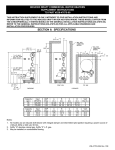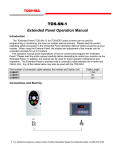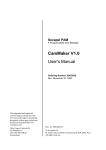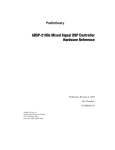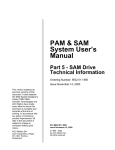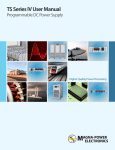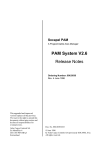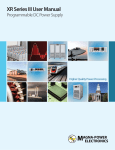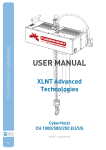Download PAM & SAM System User's Manual
Transcript
PAM & SAM System User’s Manual Part 3: Safety and Protective Functions Ordering Number: 9032 011 983 Issue October 6, 2000 This version replaces all previous versions of this document. It also replaces the SAM System Designer’s Guide (1995-1996). Inmotion Technologies and ACC Motion have made every effort to insure this document is complete and accurate at the time of printing. In accordance with our policy of continuing product improvement, all data in this document is subject to change or correction without prior notice. ACC Motion SA Zone industrielle La Rippe CH-1303 Penthaz Switzerland P/n 9032 011 983 Issue October 6, 2000 © 1995 - 2000 by ACC Motion SA All rights reserved PART 3 - SAFETY AND PROTECTIVE FUNCTIONS PAM with SAM System Users Handbook P/n 9032 011 983, October 6, 2000 TABLE OF CONTENTS Page: 2 PART 3 - SAFETY AND PROTECTIVE FUNCTIONS TABLE OF CONTENTS Table of Contents Table of Contents....................................................................................................3 Index of Figures ......................................................................................................3 Index of Tables .......................................................................................................3 Introduction .............................................................................................................5 Overview..............................................................................................................5 Definitions ............................................................................................................5 Implementation .......................................................................................................7 General Circuit Configuration ..............................................................................7 Fast DC Bus Discharge .......................................................................................7 System Power-up ..............................................................................................10 STOP 0 Initiated by a SAM Drive ......................................................................12 STOP 1 Initiated by SAM Drive .........................................................................13 External Emergency Stop with STOP 1 Controlled Stop ..................................14 Safe Power Removal.........................................................................................15 Prevention of Unexpected Start-up ...................................................................15 Index of Figures Figure 1 Figure 2 Figure 3 Figure 4 Figure 5 Figure 6 Protective and safety interlocks Circuit ....................................................8 Start-up Sequence for a PAM with SAM System...................................11 Sequence for STOP 0 initiated by a SAM Drive ....................................12 Stop 1 Sequence initiated by a SAM Drive ............................................13 Stop Sequence for an External Emergency Stop with Stop 1 controlled stop.........................................................................................................14 Sequence for Safe Standstill on Axis 2..................................................15 Index of Tables Table 1 Page: 3 Component Descriptions for Figure 1 ......................................................9 PAM with SAM System Users Handbook P/n 9032 011 983, October 6, 2000 PART 3 - SAFETY AND PROTECTIVE FUNCTIONS PAM with SAM System Users Handbook P/n 9032 011 983, October 6, 2000 INTRODUCTION Page: 4 PART 3 - SAFETY AND PROTECTIVE FUNCTIONS INTRODUCTION Introduction Overview This section describes how the built-in safety and protective functions of the PAM with SAM System may be integrated into machine level controls. The below-listed terms and definitions from IEC/EN 60204-1, ISO IEC 13849-1 (EN 954-1), and IEC 61800-5 (2nd expert committee draft 22G/64/CD) are used in the discussion of safety and protective functions and examples of their implementation are presented in this section. i Additional information on the safety and protective functions of the PAM, SAM Drive and SAM Supply is available in the "PAM Technical Information" "SAM Drive Technical Information" and "SAM Supply Technical Information" sections of this Users Handbook respectively. i The third-party test report "SAM Power Drive System Safety Related Functions for prevention of unexpected start-up and for power removal" regarding safety category 3 is available upon request for machine safety assessment. Definitions Power Drive System (PDS): It consists of a Drive (converter section, control equipment for speed, torque and current, power semiconductors, etc.), a motor (with built-in sensors), and extensions such as feeding section, field supply, and auxiliaries. It does not include the driven equipment. Requirements for Safety Related Functions: The functional safety requirements of a Power Drive System (PDS) are dependent on the application, and must be considered as a part of the overall risk assessment of the machine. The technical measures required for safety related functions depend on a combination of the consequences of faults within the PDS and the risk of injury at the machine. The Drive manufacturer may define certain control functions to be suitable for safety-critical use; however, the Drive manufacturer does not have a total "view" of the application. Consequently, the machine designer, who does have a total "view" of the application, must be responsible for the risk assessment and for specifying the safety-related requirements for the PDS. Uncontrolled stop and removal of power (STOP 0): This is a stop achieved by removal of power from the PDS. It corresponds to category 0 of IEC 60204-1. Controlled stop followed by removal of power (STOP 1): This is a controlled deceleration and stop. Power is available to the PDS for the deceleration, and then removed when the stop has been achieved. It corresponds to category 1 of IEC 60204-1. The maximum time that elapses between STOP 1 initiation and removal of power can be adjusted within SAM Drives up to a maximum duration of one second. Page: 5 PAM with SAM System Users Handbook P/n 9032 011 983, October 6, 2000 PART 3 - SAFETY AND PROTECTIVE FUNCTIONS INTRODUCTION Controlled stop without removal of power (STOP 2): This is a controlled stop with power left available to the PDS. It corresponds to category 2 of IEC 60204-1. Emergency Stop: The Emergency Stop shall function as either an uncontrolled stop (STOP 0) or a controlled stop followed by removal of power (STOP 1). The choice of the stop function shall be determined by a risk assessment of the machine. It must satisfy the following conditions: - it shall override all other functions in all modes; - power to the motors shall be removed as quickly as possible without creating other hazards; - reset shall not initiate a restart. Power removal: Power removal requires the power supply to the motor to be interrupted safely. During power removal, it shall not be possible for the motor to generate a torque resulting in hazardous movements. Measures according to i.e. Safety Category 3 shall be taken for both electromechanical and electronic means of power removal. Electronic means shall have the same safety integrity as electromechanical means. Suitable measures for power removal are for example, a line contactor between the power supply and the PDS, a motor contactor between the Drive and the motor, or safe pulse blocking of the Drive output semi-conductors. STOP - Electronic means are not adequate for protection against electric shock. - Additional measures may need to be considered to prevent stored mechanical energy from creating a hazard. - If external power influences (i.e. falling of suspended loads) are present after power removal, additional measures (i.e. mechanical brakes) shall be provided to prevent any hazard. Prevention of unexpected start-up (Safe Standstill): In some types of operations, persons exposed to moving parts of a machine can be subjected to significant risks of injury by inadvertent start-up of the machine. The PDS shall be safeguarded by technical measures against a faulty, unexpected start-up. Restarting the PDS must require a positive action such as operation of a pushbutton. Category 3 (Type 3): the term “category 3” relates to standard ISO IEC 13849-1 (EN 954-1) "Safety of Machinery - Safety-related parts of control systems", Part 1: "General Principles for Design". It is also named " type 3" in IEC 61800-5 draft. The ISO IEC 13849-1 (EN 954-1) standard says: Safety-related parts shall be designed so that: - a single fault in any of these parts does not lead to the loss of the safety function - whenever reasonably practicable the single fault is detected The standard makes the following references to system behavior: - When the single fault occurs the safety function is always performed. - Some but not all faults will be detected - Accumulation of certain faults can lead to the loss of the safety function. The standard also says that principles to achieve safety are mainly characterised by structure, and requires the use of well-tried safety principles. PAM with SAM System Users Handbook P/n 9032 011 983, October 6, 2000 Page: 6 PART 3 - SAFETY AND PROTECTIVE FUNCTIONS IMPLEMENTATION Implementation General Circuit Configuration Figure 1 illustrates a general system/machine level circuit configuration designed to satisfy the requirement of IEC/EN Standard 60204-1 regarding starting and stopping of electrical equipment in industrial machinery. A PAM with SAM system with one SAM Supply and two SAM Drives is shown; however, the concepts illustrated in Figure 1 are applicable to systems with more axes. This implementation which utilizes the built-in SAM safety and protective functions, in combination with external components, satisfies the requirements for a “safe power removal process” and prevention of unexpected start-up. Figure 1 shows standard components (switches, relays, etc.) for the sake of explaining the functionality. Achieving safety category 3 at machine level usually requires the use of redundant, safety certified relays and switches in place of single standard components. Refer to Table 1 for a functional description of the components shown in Figure 1. The system in Figure 1 has been implemented with an electromechanical brake on axis 2. Axis 1 is equipped with short-circuit dynamic braking (via K9 and RB). K9 is de-energized whenever the SAM Drive is not controlling the motor. In addition, axis 2 is shown with additional features (K7 and others) providing a “safe power removal” and preventing unexpected start-up. A PLC performing overall machine control also inputs to the circuit. Fast DC Bus Discharge STOP Page: 7 If no Fast DC-bus Discharge means is used, hazardous and lethal voltages remain for 60 seconds after removing power. Should additional DC-bus Capacitors be used, then a Fast DC-bus Discharge circuit must be used in order to keep the discharge time within 60 seconds. It shall also be used if for any reason a shorter discharge time is required. PAM with SAM System Users Handbook P/n 9032 011 983, October 6, 2000 PART 3 - SAFETY AND PROTECTIVE FUNCTIONS IMPLEMENTATION SAG001_c.cdr Figure 1 PAM with SAM System Users Handbook P/n 9032 011 983, October 6, 2000 Protective and safety interlocks Circuit Page: 8 PART 3 - SAFETY AND PROTECTIVE FUNCTIONS Symbol Description FE (3) FATAL ERROR output - one per each SAM Drive and SAM Supply. Contacts are closed whenever no fatal error condition exists. K1 AC starting relay - switches AC power to the power drive system during startup. K1 is de-energized once the DC Bus capacitance has charged. K2 AC Run relay - is energized once the DC Bus capacitance has charged and before K1 is de-energized K3 System Stop relay - de-energizing K3 forces an immediate STOP 0. The contacts in series with K3’s coil form the system stop chain. K4 Emergency Stop relay - de-energizing K4 forces an immediate STOP 1, followed after 2 seconds by a STOP 0. K5 Time delay relay - has a 2 second delay upon de-energization The 2 second delay is given here as an example. Machine safety considerations may require other delay times STOP K6 (optional) Bus Fast Discharge relay - when energized provides a path through resistance RDBR for discharging the DC Bus capacitance K7 (optional) Safe stop relay for axis 1. Relay de-energized for safe stop K9 (optional) Emergency Brake relay for axis 1. Relay operated by the brake control option. PLC1 PLC function 1 - controls application of AC power to SAM Supply via inrush resistors PLC2 PLC function 2 - controls application of AC power directly to the SAM supply PLC3 PLC function in stop chain PLC4 PLC function 4 - controls selection of fast bus discharge Q1 AC Supply circuit breaker RB (optional) Short circuit resistors - control deceleration duration during dynamic braking. With ACC motors, a short circuit may be used instead of resistors. RDBR External dynamic braking resistor RIRL In-rush current limiting resistors S1 (ESTOP) Emergency Stop push button S2 (Reset) Reset switch - used to clear the ESTOP condition and enable return to normal operation. An additional command required to restart motion. S3 safe stop switch for axis 2. A key switch is normally used. Table 1 Page: 9 IMPLEMENTATION Component Descriptions for Figure 1 PAM with SAM System Users Handbook P/n 9032 011 983, October 6, 2000 PART 3 - SAFETY AND PROTECTIVE FUNCTIONS IMPLEMENTATION System Power-up The basic circuit configuration of Figure 1 provides the interlocks necessary to insure that the PAM with SAM system cannot be set into motion unless the PAM, SAM Drives and SAM Supply have passed all power-up diagnostic checks and are ready for normal operation. Any fault/error condition producing a STOP 0 or STOP 1 condition within a SAM Drive or any fatal error condition within a SAM Supply inhibits closure of the FATAL ERROR contact on the defective unit, thereby preventing closure of K3, K2 and K1. Figure 2 illustrates a typical start-up sequence executed by a host PC/PLC using the circuit of Figure 1 along with the SAM Drive and SAM Supply status outputs. PAM with SAM System Users Handbook P/n 9032 011 983, October 6, 2000 Page: 10 PART 3 - SAFETY AND PROTECTIVE FUNCTIONS IMPLEMENTATION Apply 24 VDC Power 20 sec. delay Establish communication NO Communication OK? YES NO DC BUS LOW = 1 OVERTEMP = 0 DBR OVERLOAD = 0 OVERVOLTAGE = 0 SAM Supply Status OK? YES NO SAM Drive Status OK? YES >10s since last Start-Up? Abort Start-Up NO YES Close PLC1 WAIT 0.3 s NO Open PLC1 DC BUS LOW = 0? YES Close PLC2 Abort Start-Up Open PLC1 Start-Up completed sag006_b.dsf Figure 2 Page: 11 Start-up Sequence for a PAM with SAM System PAM with SAM System Users Handbook P/n 9032 011 983, October 6, 2000 PART 3 - SAFETY AND PROTECTIVE FUNCTIONS IMPLEMENTATION STOP 0 Initiated by a SAM Drive A SAM Drive executes a STOP 0 when it detects a serious error condition (i.e. short-circuit in motor cable) requiring immediate removal of output power to the motor and AC power to the drive system. Figure 3 shows the sequence of events in the drive system illustrated in Figure 1 when axis 2 executes a STOP 0. Note that Axis 2 (aided by the brake on the axis motor) executes an immediate uncontrolled stop. Energy stored in DC Bus circuit helps stop axis 1 in a controlled way (STOP 1) after the AC Supply is disconnected. Axis 2 initiates a Stop 0 due to internal error condition Axis 2 Power Stage disabled Axis 2 fatal error relay opens K3 deenergized Brake Control turns off brake current Axis 2 Axis 2 mechanical brake actuates Axis 2 Stop0 executed status bit set Some delay Host controller detects status change on axis2 K1 & K2 deenergized K4 deenergized AC Supply disconnected K5 deenergized Stop 1 to Axis1 & Axis2 2 seconds delay Axis1 controlled stop 1 second delay Stop 0 to Axis1 & Axis2 Max. 1 second delay Host closes contact PLC4 Axis1 power stage disabled Host opens contacts PLC1 & PLC2 and stop the whole machine K6 energized Discharge DC Bus sag002_b.dsf Figure 3 PAM with SAM System Users Handbook P/n 9032 011 983, October 6, 2000 Sequence for STOP 0 initiated by a SAM Drive Page: 12 PART 3 - SAFETY AND PROTECTIVE FUNCTIONS IMPLEMENTATION STOP 1 Initiated by SAM Drive A SAM Drive executes a STOP 1 when it detects an error condition (i.e. motor overload) necessitating a controlled stop of the drive system. Figure 4 shows the sequence of events in the drive system of Figure 1 when axis 1 executes a STOP 1. In this example, the host controller, upon sensing the STOP 1 condition on axis 1, issues a STOP 1 command to axis 2. Axis 1 initiates a Stop 1 due to internal error condition Axis 1 executes controlled stop Axis 1 "Stop1 executed" status bit set Small delay Some delay Axis 1 Power stage disabled Axis 1 brake control turns off brake curent Host controller detects status change on Axis 1 Axis 1 "Fatal error" relay opens K9 deenergized Host controller orders Stop1 to the whole machine K3 denergized Some delay K4 deenergized Host controller opens contacts PLC1 & PLC2 K5 deenergized Stop1 to Axis 1 & Axis 2 Some delay 2 seconds delay Axis 2 controlled stop Host closes contact PLC4 Stop 0 to Axis 1 & Axis 2 Max, 1 sec. delay K6 energized Axis 2 power stage disabled Discharge DC Bus K1 & K2 deenergized AC Supply disconnected from SAM System R B short-circuit Axis 1 motor sag003_b.dsf Figure 4 Page: 13 Stop 1 Sequence initiated by a SAM Drive PAM with SAM System Users Handbook P/n 9032 011 983, October 6, 2000 PART 3 - SAFETY AND PROTECTIVE FUNCTIONS IMPLEMENTATION External Emergency Stop with STOP 1 Controlled Stop Figure 5 illustrates the sequence when an external Emergency Stop (ESTOP) button on the machine is actuated. ESTOP Switch actuated (switch opens) K4 deenergized K5 deenergized Host controller detects K4 open Axes executes Stop1 commands 2 seconds delay Host controller stops the whole machine Max. 1 sec. delay Stop0 to all axes K1 & K2 deenergized Stop1 to all axes All axes power stages disabled (Safety cat. 3) AC Supply disconnected from SAM System Some delay Host controller closes contact PLC4 K6 energized Discharge DC bus sag004_b.dsf Figure 5 PAM with SAM System Users Handbook P/n 9032 011 983, October 6, 2000 Stop Sequence for an External Emergency Stop with Stop 1 controlled stop Page: 14 PART 3 - SAFETY AND PROTECTIVE FUNCTIONS IMPLEMENTATION Safe Power Removal Once one second has elapsed upon Emergency Stop activation, the system configuration of Figure 1 and the sequences of Figure 5 satisfy the requirements for safe power removal, according to safety category 3. Prevention of Unexpected Start-up The system configuration of Figure 1 satisfies the requirements for prevention of unexpected start-up. Starting from the condition of the machine not running (at an Emergency stop condition), axis 2 motor may be isolated by setting S3 to the open position. Figure 6 illustrates the sequence. Any single fault within SAM drive 2 while axis 2 is isolated produces a STOP 0 error and result in opening of its "Fatal Error" relay which, in turn, stops the entire drive system and disconnects it from the AC Supply. S3 is normally a key operated switch. To ensure that others cannot remove the safe standstill condition, the operator normally removes the key from the switch. Machine is at an operational stop condition (PLC5 opened) S3 opens K7 deenergized Axis 2 Brake Control turns off brake current Stop1 to Axis 2 Axis 2 mechanical brake actuates Max. 1 sec. delay Stop0 to Axis 2 Axis 2 power stage disabled (Safety cat. 3) sag005_b.dsf Figure 6 Page: 15 Sequence for Safe Standstill on Axis 2 PAM with SAM System Users Handbook P/n 9032 011 983, October 6, 2000















